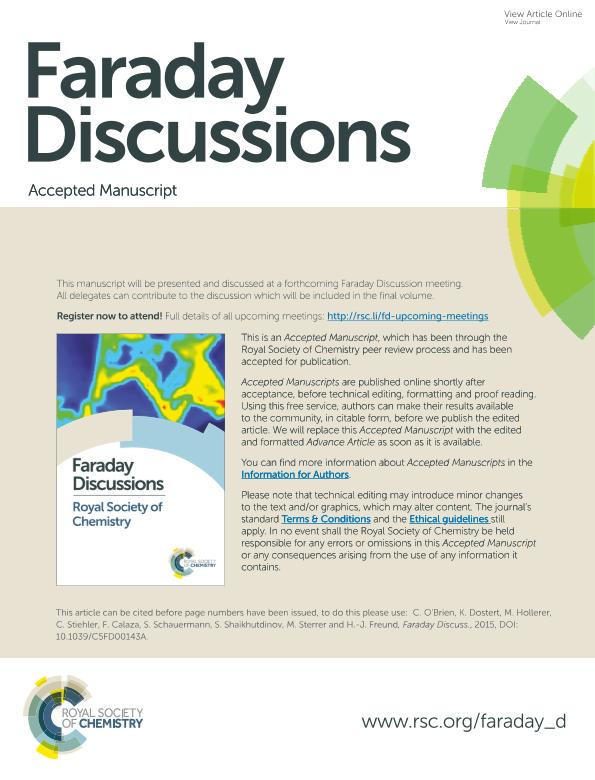Mostrar el registro sencillo del ítem
dc.contributor.author
Obrien, C. P.
dc.contributor.author
Dostert, K. H.
dc.contributor.author
Hollerer, M.
dc.contributor.author
Stiehler, Christian
dc.contributor.author
Calaza, Florencia Carolina

dc.contributor.author
Schauermann, S.
dc.contributor.author
Shaikhutdinov, S.
dc.contributor.author
Sterrer, M.
dc.contributor.author
Freund, H. J.
dc.date.available
2017-07-04T18:48:07Z
dc.date.issued
2016-07
dc.identifier.citation
Obrien, C. P.; Dostert, K. H.; Hollerer, M.; Stiehler, Christian; Calaza, Florencia Carolina; et al.; Supports and Modified Nano-particles in Designing Model Catalysts; Royal Society Of Chemistry; Faraday Discussions; 188; 7-2016; 309-321
dc.identifier.issn
1364-5498
dc.identifier.uri
http://hdl.handle.net/11336/19490
dc.description.abstract
In order to design catalytic materials, we need to understand the essential causes for material properties resulting from its composite nature. In this paper we discuss two, at first sight, diverse aspects: a) the effect of the oxide-metal interface on metal-nanoparticle properties and b) the consequences of metal particle modification after activation on the selectivity of hydrogenation reactions. However, those two aspects are intimately linked. The metal-nanoparticles electronic structure changes at the interface as a catalyst is brought to different reaction temperatures due to morphological modifications in the metal and, as we will discuss, those changes the chemistry leading to changes in the reaction path. As the morphology of the particle varies, facets of different orientation and size are exposed which may lead to a change in surface chemistry as well. We use two specific reactions to address those issues in some detail. To the best of our knowledge the present paper reports the first observations of this kind for well-defined model systems. The changes of the electronic structure of Au nanoparticles due to their size and interaction with a supporting oxide are revealed as a function of temperature using CO2 activation as a probe. The presence of spectator species (oxopropyl) as formed during an activation step of acrolein hydrogenation, strongly controls the selectivity of the reaction towards hydrogenation of the unsaturated C-O vs. the C-C bond on Pd(111) when compared with oxide supported Pd nanoparticles.
dc.format
application/pdf
dc.language.iso
eng
dc.publisher
Royal Society Of Chemistry

dc.rights
info:eu-repo/semantics/openAccess
dc.rights.uri
https://creativecommons.org/licenses/by-nc-sa/2.5/ar/
dc.subject
Oxide-Metal Interface
dc.subject
Nanoparticle Properties
dc.subject
Activation of Particles
dc.subject
Hydrogenation Reactions
dc.subject.classification
Físico-Química, Ciencia de los Polímeros, Electroquímica

dc.subject.classification
Ciencias Químicas

dc.subject.classification
CIENCIAS NATURALES Y EXACTAS

dc.title
Supports and Modified Nano-particles in Designing Model Catalysts
dc.type
info:eu-repo/semantics/article
dc.type
info:ar-repo/semantics/artículo
dc.type
info:eu-repo/semantics/publishedVersion
dc.date.updated
2017-06-08T19:27:46Z
dc.journal.volume
188
dc.journal.pagination
309-321
dc.journal.pais
Reino Unido

dc.journal.ciudad
Cambridge
dc.description.fil
Fil: Obrien, C. P.. US Army Research Laboratory; Estados Unidos
dc.description.fil
Fil: Dostert, K. H.. Fritz-Haber Institut der Max-Planck Gesellschaft; Alemania
dc.description.fil
Fil: Hollerer, M.. University of Graz; Austria
dc.description.fil
Fil: Stiehler, Christian. Fritz-Haber Institut der Max-Planck Gesellschaft; Alemania
dc.description.fil
Fil: Calaza, Florencia Carolina. Consejo Nacional de Investigaciones Científicas y Técnicas. Centro Científico Tecnológico Conicet - Santa Fe. Instituto de Desarrollo Tecnológico para la Industria Química. Universidad Nacional del Litoral. Instituto de Desarrollo Tecnológico para la Industria Química; Argentina. Fritz-Haber Institut der Max-Planck Gesellschaft; Alemania
dc.description.fil
Fil: Schauermann, S.. Fritz-Haber Institut der Max-Planck Gesellschaft; Alemania
dc.description.fil
Fil: Shaikhutdinov, S.. Fritz-Haber Institut der Max-Planck Gesellschaft; Alemania
dc.description.fil
Fil: Sterrer, M.. University of Graz; Austria
dc.description.fil
Fil: Freund, H. J.. Fritz-Haber Institut der Max-Planck Gesellschaft; Alemania
dc.journal.title
Faraday Discussions

dc.relation.alternativeid
info:eu-repo/semantics/altIdentifier/doi/http://dx.doi.org/10.1039/C5FD00143A
dc.relation.alternativeid
info:eu-repo/semantics/altIdentifier/url/http://pubs.rsc.org/en/Content/ArticleLanding/2016/FD/C5FD00143A
Archivos asociados
